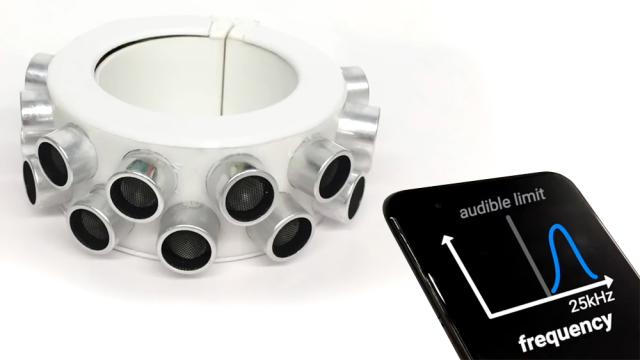You can prevent facial recognition cameras from identifying you by wearing face paint, masks, or sometimes just a pair of oversized sunglasses. Keeping conversations private from an ever-growing number of microphone-equipped devices isn’t quite as easy, but researchers have created what could be the first wearable that actually helps increase your privacy.
You probably don’t realise just how many devices in your home or workplace are not only capable of eavesdropping on all your conversations but are specifically designed to. Smartphones, tablets, computers, smartwatches, smart speakers, even voice-activated appliances that have access to smart assistants like Amazon’s Alexa or Google Assistant feature built-in microphones that are constantly monitoring conversations for specific activation words to bring them to life. But accurate voice recognition often requires processing recordings in the cloud on faraway servers, and despite what giant companies keep assuring us, there are obvious and warranted concerns about privacy.
You could simply find yourself a lovely cave deep in the woods and hide out the rest of your days away from technology if you don’t want to be the victim of endless eavesdropping, but this wearable jammer, created by researchers from the University of Chicago, is a (slightly) less drastic alternative. It’s chunky, there’s no denying it, but surrounding an inner core of electronics and batteries are a series of ultrasonic transducers blasting sound waves in all directions. While inaudible to human ears, the ultrasonic signals take advantage of a flaw found in sensitive microphone hardware that results in these signals being captured and interfering with the recordings of lower parts of the audio spectrum where the frequencies of human voices fall.
The results are recordings that are nearly incomprehensible to both human ears and the artificial intelligence-powered voice recognition software that smart assistants and other voice-activated devices rely on.
But why pack the technology into a wearable bracelet instead of creating a stationary device you could set up in the middle of a room for complete privacy? An array of transducers pointing in all directions are needed to properly blanket a room in ultrasonic sound waves, but thanks to science, wherever the signals from two neighbouring transducers overlap, they cancel each other out, creating dead zones where microphones could continue to effectively operate.
By incorporating the jamming hardware into a wearable device, the natural and subconscious movements of the wearer’s arms and hands while they speak keep the transducers in motion. This effectively eliminates the risk of dead zones being created long enough to allow entire words or sentences to be detected by a smart device’s microphone. For those who are truly worried about their privacy, the research team has shared their source code for the signal generator as well as 3D models for the bracelet on GitHub for anyone to download and build themselves. You’ll need to supply your own electronics, and if you’re going to all the trouble, you might as well build one for each wrist, all but ensuring there’s never a dead zone in your silencing shield.
